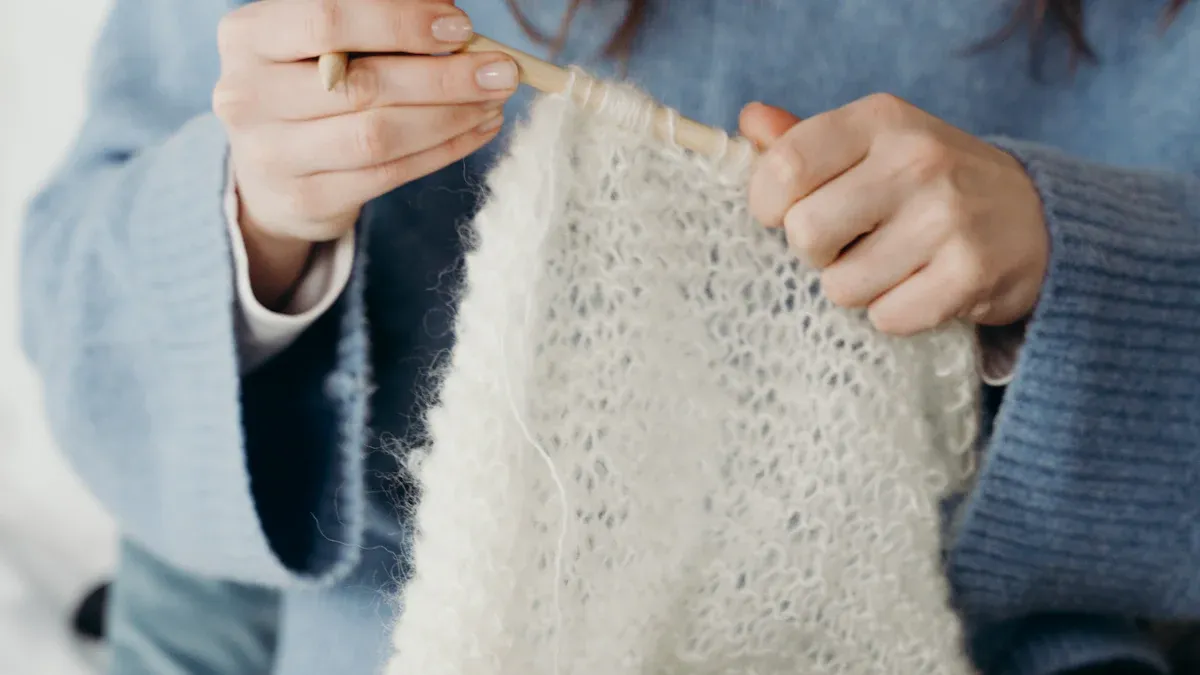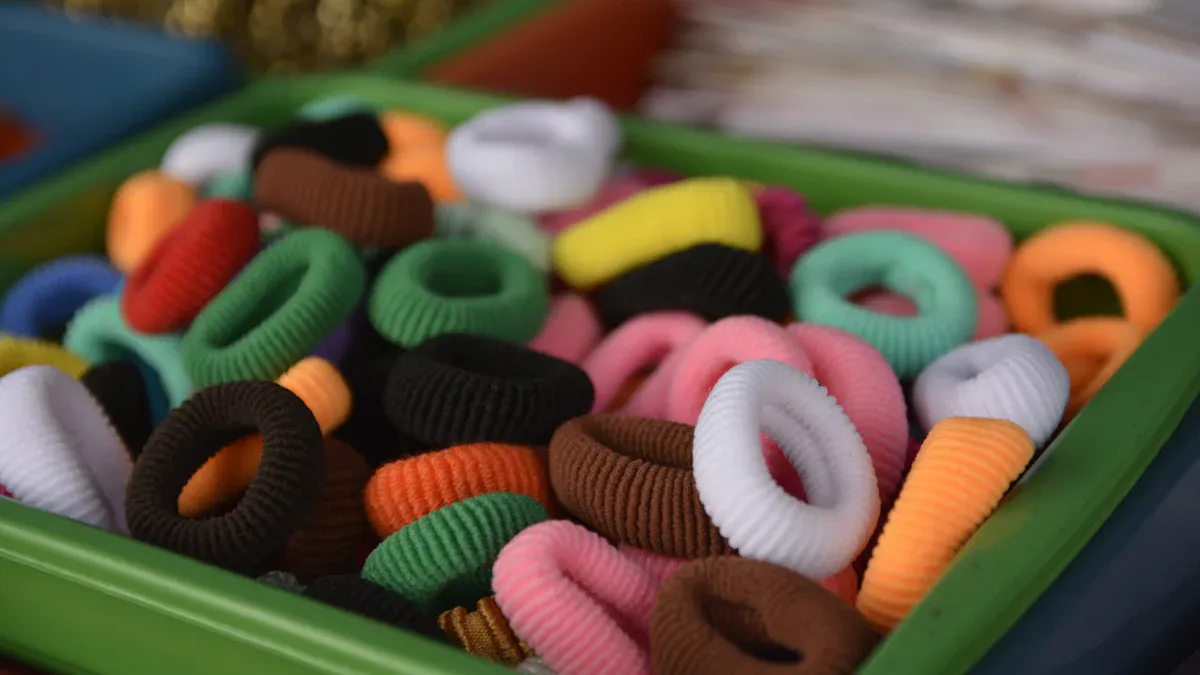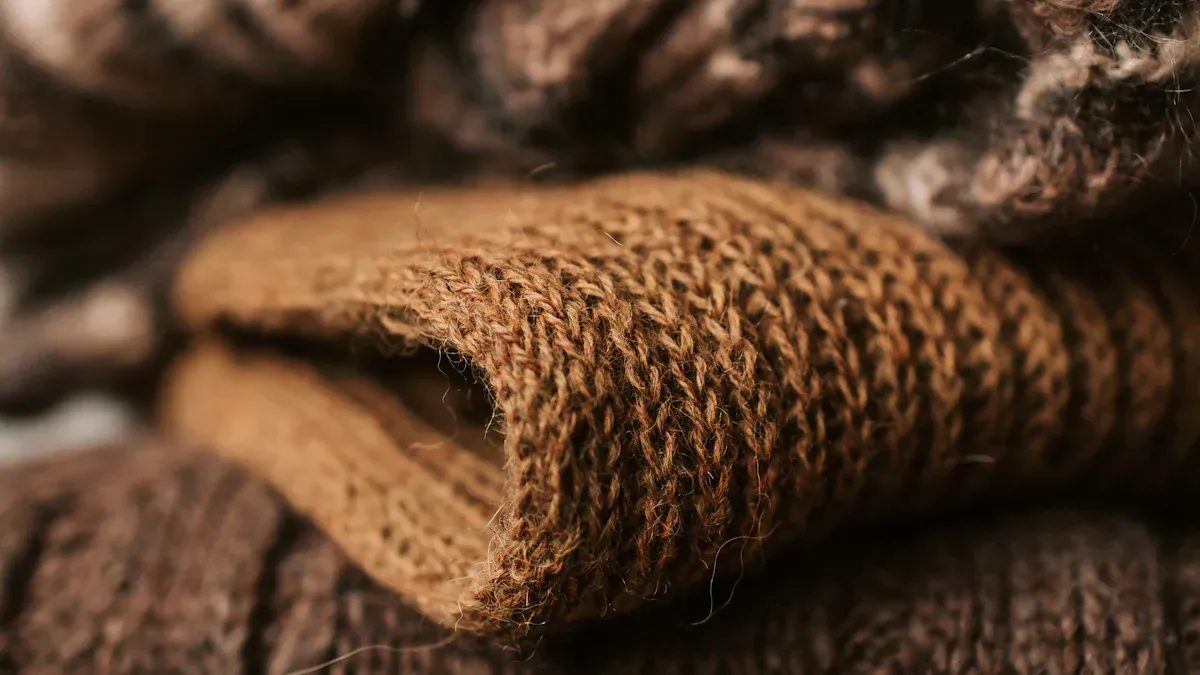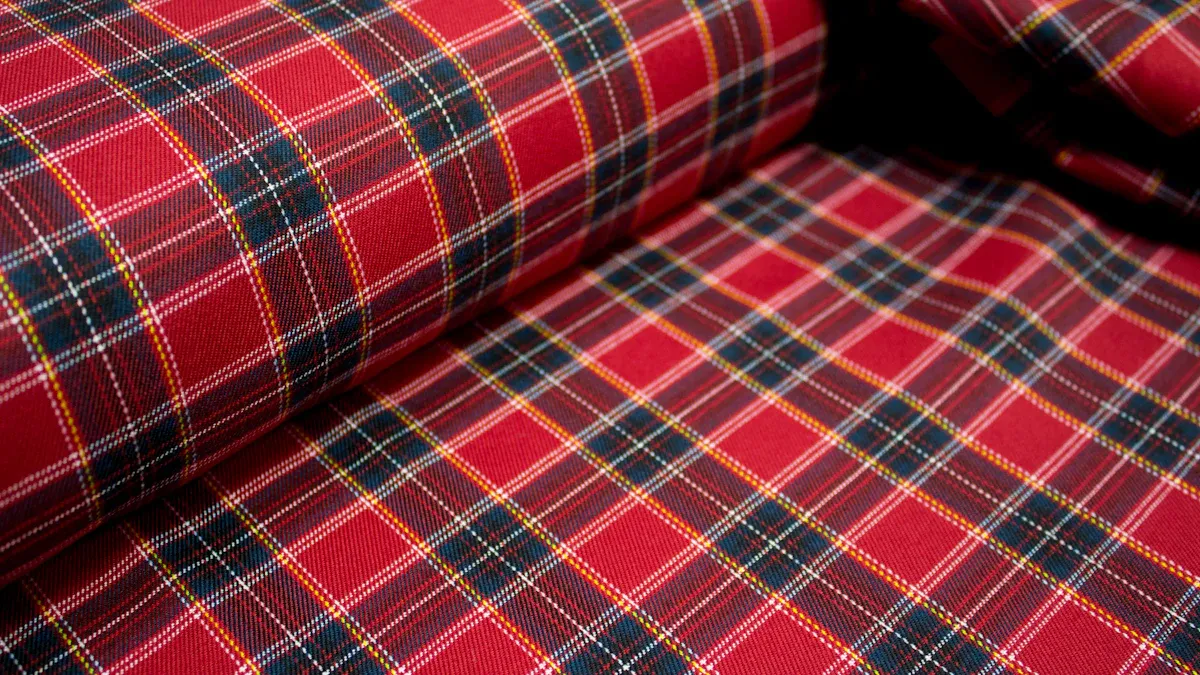
If you want to skip ribbing fabric, you have plenty of options for your next project. You can use a folded hem, mock ribbing, or even garter stitch for a stretchy edge. Some crafters love nylon spandex mesh or knit fabric with stretch for a smooth finish. Faux ribbing and mock-cable rib look just like classic ribbed trim. Stocking stitch hems and decorative ribbing patterns also give you a neat edge. Try these choices when ribbing fabric or ribbed trim feels too limiting. You might find a new favorite!
Key Takeaways
- There are many choices instead of ribbing fabric. You can use folded hems, mock ribbing, garter stitch, or stretchy knit fabrics. These give you more colors and textures to pick from. Using other options helps you match fabric types and weights better. This makes your clothes feel nicer and look more finished. Some choices, like nylon spandex mesh and stretchy knit fabric, are good for activewear. They give soft and flexible edges. You can also use cables, fancy edgings, and fake ribbing for a special look. These add cool style and texture to your work. Try new edge finishes on small pieces first. This helps you check the stretch, fit, and look before you finish your clothes.
Why Use Alternatives?
When Ribbing Isn’t Ideal
You might love the look of ribbing, but sometimes it just doesn’t work for your project. Maybe you can’t find ribbing fabric in the right color or weight. This happens a lot, especially if you shop online and the colors don’t match your main fabric. Sometimes, ribbing comes in only a few shades, and you want something special. You might also worry about the fiber content. Ribbing often has synthetic fibers, but your main fabric is all cotton or wool. Mixing them can change how your garment feels or stretches.
Some projects need a lighter or heavier edge. For example, a hoodie waist might need thick ribbing, but a coat could look bulky with it. You might want to avoid a homemade look, too. Some alternatives can look more polished or professional. People even use narrow elastic stitched in rows or repurpose ribbed sections from socks. Heavy slinky knits or spandex activewear fabrics work well for cuffs and bindings. If you can’t find a perfect match, you might use self-fabric cuffs or even a contrasting color. Sometimes, you just want to try something new!
Tip: If you struggle to find matching ribbing, don’t stress. Many makers use contrasting ribbing or creative alternatives for a unique touch.
Benefits of Alternatives
Trying alternatives to ribbing opens up a world of options. You get to pick from many fabrics and techniques. Folded hems, mock ribbing, or garter stitch can give your project a fresh look. Some alternatives stretch almost as well as ribbing, while others add a smooth or decorative finish. You can match your main fabric perfectly by using self-fabric cuffs. This makes your garment look more custom and professional.
- More choices for color and texture
- Better control over fiber content
- Options for different weights and finishes
- Creative ways to add style and personality
You don’t have to settle for what’s in the store. You can use what you have or try something bold. Alternatives let you solve problems and make your projects stand out. Sometimes, you’ll even find a new favorite method!
Alternatives to Ribbing Fabric for Sewing and Knitting

Folded Hem: A Simple and Versatile Alternative to Traditional Ribbing
A folded hem gives your project a neat edge. You fold the fabric edge inside and sew it down. This works for sleeves, necklines, and sweater bottoms. Folded hems do not stretch much, but they look tidy. You can use this on both knit and woven fabrics. If you want a smooth edge or need an exact match, try a folded hem. It is easy to sew and good for beginners.
Tip: Add a strip of lightweight interfacing to help your folded hem keep its shape.
Mock Ribbing: Creating the Look of Ribbing Without Traditional Ribbing Fabric
Mock ribbing lets you make ribbed trim without special fabric. You use knit, purl, and slip stitches for a textured pattern. This is easy to learn and only takes two rows to remember. Mock ribbing gives a classic look with texture. It does not stretch as much as real ribbing. Use it for places where you want the look, not the stretch, like cuffs or necklines.
- Looks like ribbed trim with texture
- Easy to knit with basic stitches
- Not as stretchy as ribbing fabric
- Good for decorative edges
Garter Stitch: A Classic Knitting Technique for Stretchy and Textured Edges
Garter stitch is great for a simple, flat edge. You knit every row to make a bumpy, stretchy fabric. Garter stitch does not curl, so edges stay flat. It is easy to knit and good for beginners. Here’s how garter stitch compares to ribbing fabric:
| Feature | Garter Stitch | Ribbing |
|---|---|---|
| Elasticity | Less elastic, more relaxed fit | Very stretchy, provides snug fit |
| Edge Behavior | Lies flat, does not curl | Can curl, often used for stretchy edges |
| Ease of Knitting | Easy, suitable for beginners | More complex than garter stitch |
| Suitability for Edges | Good for edges that should stay flat | Preferred for cuffs and hems needing elasticity |
Use garter stitch for scarves, sweater edges, or anywhere you want a flat finish.
Twisted Rib: Adding Subtle Texture and Stretch with a Unique Knitting Technique
Twisted rib uses twisted knit stitches for a tight, crisp trim. This makes the fabric stronger and helps it last longer. Twisted rib is less stretchy than regular ribbing, but it keeps its shape well. Here’s a quick look at how twisted rib compares to other rib stitches:
| Rib Type | Construction Pattern | Performance in Stretch and Durability |
|---|---|---|
| 1×1 Rib | Alternating single knit & purl | Highly elastic, close fit, retains shape well |
| 2×2 Rib | Two knit stitches, two purl | Good stretch, thicker texture, less stretch than 1×1 |
| Twisted Rib | Twisted knit stitches | Tighter fabric, more durable, lasts longer, less stretchy |
Pick twisted rib when you want a strong edge that keeps its shape, like on cuffs or neckbands.
Cables: Enhancing Edges with Intricate Texture and Structure
Cable patterns can make a plain edge look special. You can add cable twists to a ribbed hem or use shaped ribbing for points or scallops. Some knitters mix twisted rib with brioche stitches for a wavy band. Folded trims with cables look neat and can hide a pop of color inside. Here’s a quick guide to popular cable alternatives:
| Cable Pattern Alternative | Description | Key Features and Effectiveness |
|---|---|---|
| Ribbing with Cables | Adds cable twists to a ribbed trim. | Works well when cables continue into the main fabric or show against stockinette; simple 3-stitch cables flow from 1×1 rib. |
| Twisted Rib with Brioche | Mixes twisted ribbing with plush brioche stitches. | Makes textured, squishy bands with a wave; best knitted in the round or seamed to avoid messy edges. |
| Sandwich (Folded) Trim | Folded trim often knitted in the round, sometimes with different inner colors. | Gives a neat edge; contrasting colors add detail; best in finer yarns to avoid bulkiness. |
| Shaped Ribbing | Moves rib sections inward to form points or scallops. | Adds depth and interest; can go into the garment body; allows creative shaping beyond classic ribbing. |
Try cables when you want your trim to stand out or add structure.
Decorative Edgings: Creative Finishing Touches for Unique and Stylish Garment Edges
Decorative edgings let you add style to your project. You can use lace, picot, or scalloped edges for a fancy finish. Crochet borders work well on both knit and sewn garments. These edgings do not stretch like ribbing, but they look pretty and unique. Use them on sleeves, necklines, or sweater bottoms when you want your project to stand out.
Note: Always test your edging on a small swatch to see how it looks and feels before adding it to your garment.
Nylon Spandex Mesh: A Lightweight and Stretchy Substitute for Traditional Ribbing
Nylon spandex mesh is a modern choice for stretchy edges. This fabric is light, breathable, and stretches well. You can use it for cuffs, waistbands, or necklines. Nylon spandex mesh gives a smooth, sporty look. It is easy to sew and comes in many colors. This is perfect for activewear or light clothes that need a flexible edge.
Knit Fabric with Stretch: A Flexible and Comfortable Alternative to Ribbing for Edges and Cuffs
You can use any knit fabric with stretch instead of ribbing. Cut a strip of your main fabric or a matching knit, then sew it to your edge. This gives a soft, comfy finish that matches your garment. Knit fabric with stretch works for cuffs, waistbands, and necklines. It is easy to sew and helps your project look neat and professional.
Faux Ribbing Fabric: Achieving the Ribbed Look with Alternative Materials and Techniques
Faux ribbing fabric lets you get the ribbed look without real ribbing. You can use pintucks, pleats, or elastic thread to make raised lines. Faux ribbing is good for a custom look or matching a tricky color. It works on both knit and woven fabrics. This method is easy to try and gives your project a unique twist.
Stocking Stitch Hem: A Smooth and Subtle Edge Alternative for Knitted Garments
A stocking stitch hem gives your garment a smooth, rolled edge. You knit a few rows in stocking stitch and let the edge curl. This finish looks neat and works for light sweaters or baby clothes. Stocking stitch hems do not stretch much, but they add a soft touch. Use this method when you want a simple, classic look.
Mock-Cable Rib: Achieving a Ribbed Effect with Decorative Cable-Like Stitches
Mock-cable rib is a smart way to get the look of cables without hard work. You use twist stitches, slipped stitches, and yarnovers to cinch the ribs and make a bold effect. Mock-cable rib is faster and uses less yarn than real cables. It is flexible and works best on stockinette backgrounds, where it stands out. Try mock-cable rib when you want dramatic texture and flexibility without the complexity of real cables.
Alternative Ribbing Patterns: Exploring Creative and Functional Options for Edging and Cuffs
You can try many new patterns instead of classic ribbing. Some popular choices are:
- Pleated patterns
- Polka dot patterns
- Quilted lattice patterns
- Reversible cables
- Ruffled patterns
- Ripple lace
- Ruched and gathered patterns
- Seafoam and wavy drop stitch patterns
- Shaker rib patterns
- Waffle stitch patterns
These patterns add texture, stretch, or style to your hem or cuff. They work well when you want your trim to stand out or match a special style.
Remember: When you try a new alternative, make a small sample first. This helps you check the stretch and fit before you finish your project. Always finish your edges neatly and test the snugness of your cuff or band to avoid common mistakes.
Comparing Ribbing Fabric and Its Top Alternatives

Elasticity: How Different Alternatives Compare in Stretch and Recovery
You want your garment edges to stretch and bounce back. Ribbing gives you the most stretch and recovery. It hugs your wrists, waist, or neck and keeps its shape. Folded hems and stocking stitch hems do not stretch much. Garter stitch and mock ribbing offer some stretch, but not as much as real ribbing. Nylon spandex mesh and knit fabric with stretch can work well for activewear because they move with you. If you need a snug fit, ribbing or stretchy knit fabric is your best bet.
Visual Appeal: How the Look of Each Alternative Compares to Traditional Ribbing
Each edge finish gives a different look. Ribbing looks classic and sporty. Folded hems look clean and simple. Garter stitch and twisted rib add texture. Cables and mock-cable rib create bold, eye-catching edges. Decorative edgings like lace or ruffles make your project stand out. Faux ribbing and mock ribbing can trick the eye and look almost like the real thing. You can match your style by picking the right finish.
Ease of Use: Evaluating the Simplicity and Practicality of Each Ribbing Alternative
Some finishes are easier than others. Folded hems are quick and simple. You just fold and sew. Garter stitch is easy for knitters. Ribbing takes more time and skill, but it gives great results. Faux ribbing and mock-cable rib need a bit more practice. Nylon spandex mesh and knit fabric with stretch are easy to sew, especially if you use a zigzag stitch. If you want a fast finish, try a folded hem or stretchy knit fabric.
Best Uses for Each Ribbing Alternative: Choosing the Right Option for Your Project
You can pick the best edge based on your fabric and project. Here’s a handy table to help you decide:
| Ribbing Alternative | Fabric Type | Best Projects and Uses |
|---|---|---|
| 1×1 Rib Knit | Cotton with spandex | Fitted t-shirts, turtlenecks, loungewear |
| 2×2 or 3×3 Rib Knit | Cotton/poly blends | Joggers, activewear, cuffs, neckbands, waistbands |
| Variegated Rib Knit | Various fibers | Decorative trims, stylish cuffs, neckbands |
| Wool Rib Knit | Wool | Sweaters, scarves, cold-weather garments |
| Rayon Rib Knit | Rayon | Dresses, flowy tops, comfy loungewear |
| Bamboo Rib Knit | Bamboo | Baby clothes, moisture-wicking activewear |
Tip: Always match your edge finish to your fabric and how you want your garment to feel and look.
You have so many ways to finish your garment edges. Don’t be afraid to try something new! Many sewists and knitters say you get the best results by experimenting. Here’s what others have found helpful:
- Use the same knit fabric as your main piece for a perfect match.
- Try shirring with elastic thread for stretch.
- Cut double knit on the cross grain for a rib-like look.
- Repurpose ribbing from socks for small projects.
Every project teaches you something new. Share your tips or questions below—your ideas might help someone else!
FAQ
Can I use regular knit fabric instead of ribbing for cuffs?
Yes, you can! Just cut a strip of stretchy knit fabric. Make sure it stretches enough to fit over your hand or foot. Sew it on like you would ribbing. You get a comfy and matching finish.
How do I make a folded hem look neat?
Press the edge with an iron before sewing. Use a straight stitch or a zigzag for stretch. Pin the hem in place. Take your time and sew slowly. You get a smooth, professional look every time.
What’s the best alternative for stretchy waistbands?
Try nylon spandex mesh or a wide strip of stretchy knit fabric. Both give you comfort and flexibility. You can also add elastic inside for extra hold. These options work great for activewear and everyday clothes.
Will mock ribbing stretch as much as real ribbing?
Mock ribbing looks like real ribbing, but it does not stretch as much. It works well for decorative edges or loose cuffs. If you want a snug fit, use real ribbing or a very stretchy knit fabric.
Can I use decorative edgings on kids’ clothes?
Absolutely! Decorative edgings like lace or crochet add fun details. Just make sure the trim feels soft and does not scratch. Test a small piece first. Kids love unique touches on their clothes!



